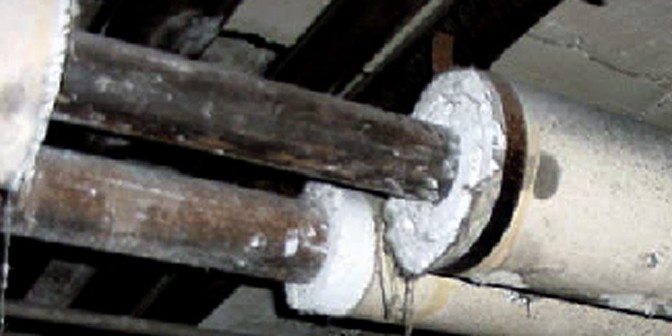Asbestos is a naturally occurring mineral that is resistant to fire, cold transfer, chemicals and or/ultraviolent light degradation. The fibers of asbestos minerals are very strong, durable and some have a tensile strength that is equal to steel. By Coulter Bright of Bend Environmental, Inc., Bend, Oregon
Due to the heat resistance and fiber strength, asbestos has been used in some building materials as a fire retardant and insulation. Asbestos is rarely used in its natural state as a building material. It is generally mixed with other materials in various percentages. Sheet vinyl flooring, gaskets, roofing shingles, mastic (glue) and heat-resistant fabrics are just a few of the manufactured building materials that have been used with asbestos.
An asbestos containing material is often abbreviated as the acronym (ACM) ACM is defined by the Environmental Protection Agency (EPA) as any material that contains more than 1% asbestos. To determine if the building material does or does not contain asbestos, samples must be taken, sent to an accredited lab; national voluntary laboratory accreditation program (NVLAP) and tested using the Polarized Light Microscopy method. If the laboratory results reveal the building material is less than 1 percent asbestos, then it is considered a non-ACM.
ACM is considered either a friable or non-friable material. According to the EPA, friable ACM is a material that “can be crumbled, pulverized or reduced to powder by hand when dry. “ A non-friable ACM is sometimes referred as cementitious, and cannot be crumbled, pulverized or reduced to powder by hand when dry. However, it is possible for a non-ACM to become friable under certain conditions, for example demolishing a building and removal of ACM that has been fastened with mastic (glue)
Here are 3 popular myths about asbestos:
Myth #1: All asbestos products are banned in the USA.
From 1973-1989 many of the asbestos containing building materials were banned by the EPA and in 1989, the EPA issued a final rule under section 6 of Toxic Substance Control Act (TSCA) banning most asbestos containing products. In 1991the fifth Circuit Court of Appeals in New Orleans overturned the 1989 ruling on the ban for the majority of the asbestos-containing products covered in the 1989 final ruling.
The asbestos-containing products and uses that are currently banned by the courts ruling are: rollboard, floor felting, commercial, corrugated or specialty paper, asbestos pipe insulation, block insulation spray—applied surfacing materials, spray-on application of materials containing more than 1 % asbestos to buildings, structures, pipes, conduits, artificial fireplace embers, wall patching compounds and “new uses” of asbestos.
Myth #2: A person can smell taste the asbestos in the air and it is causing them to cough.
Asbestos is odorless and tasteless and there is no know level of exposure to asbestos fibers that cause immediate symptoms or death. The symptoms of asbestos exposure do not manifest themselves until 20-40 years later, depending on the disease. The time from exposure until symptoms are evident is called the latency period.
Myth #3: Having asbestos in your home is dangerous.
Asbestos only becomes a problem if it becomes friable (damaged), which causes the fibers to become air born. The inhaled fibers are what build up in the lungs and can cause health problems. If the material is in good condition and intact, it poses no immediate health threat.
Firms like mine are called in to conduct an asbestos survey’s to identify, quantify and assess the condition (friable or non-friable) of the suspect asbestos containing materials. We send each sample to an accredited lab (NVLAP) to determine if the samples are asbestos or non-asbestos containing materials. If the materials come back positive for asbestos, then we will refer and recommend a licensed abatement contractor to conduct abatement in order to meet the needs of our customers.
If you have questions or concerns about asbestos, you can find invaluable information on the Oregon Department of Environmental Quality (DEQ) website.
www.oregon.gov/deq/ER/pages/index.aspx or the EPA website
www2.epa.gov/asbestos
Bend Environmental, Inc. is a testing and consulting company specializing in environmental hazards. They provide pre-demolition inspections, surveys and post abatement clearance testing for asbestos as well as pre and post testing for bacteria and mold remediation. They perform inspections on all types of buildings, both residential and commercial, and clients include insurance companies, homeowners, property management companies, contractors and realtors.
Coulter Bright
President and Owner of Bend Environmental, Inc.
740 NE 3rd Street Suite 3 # 268
Bend, OR 97701
541-797-2184
Coulter@BendEnvironmental.com
www.BendEnvironmental.com





1 Comment
I didn’t know that the effects of asbestos exposure may not show up for 20-40 years. It makes sense that it would be really important to have your house tested, because there would be no warning otherwise. Our house is pretty old, so I’m sure there is a good chance that there is asbestos in the materials used to build it. I should have it inspected to make sure it is still intact and not dangerous.